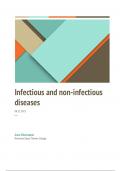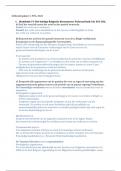Infectious and non-infectious
diseases
08.11.2022
─
Anna Dharmapuri
Richmond Upon Thames College
, 1
Case Studies:
Infectious disease - Flu -
To gain the flu, you can admit it from close contact with someone who
presently has the flu by spreading substantially through driblets by sneezing,
coughing or talking. Ranging from 2 days it'll take for a person to realize or
show the flu symptoms. Influenza contagion causes an infection in the
respiratory tract, nose, throat and lungs, gobbled or circulated, generally
through your fingers, to the mucous membranes of the mouth, nose, and
eyes; this is how the contagion is congested. It also transits down the
respiratory tract and affixes to epithelial cells lining the lung airways via
distinctive molecules on the cell face. Once inside the cells, the contagion
seizes the protein manufacturing ministry of the cell to develop its own viral
proteins and construct other viral patches. Once mature viral patches are
created, they're terminated from the cell and can also go on to infest touching
cells. In addition to affecting your daily activities, the flu also causes missed
work and school days. Symptoms of pneumonia, ear or sinus infections,
dehydration, and worsening of chronic medical conditions, such as asthma,
diabetes, or congestive heart failure, can occur. Anyone with a weak immune
system, elderly people, and people with chronic diseases can die from the flu.
The flu makes you feel lousy for a whole lot longer, and it makes the other
things you feel lousy about feel a whole lot worse. It is especially common for
young people with pre-existing mental disorders to experience worsening
moods and anxiety during the flu season. Inflammation plays a role in
psychiatric distress, and since the flu induces a high level of inflammation in
your body, this inflammation likely worsens your psyche. The proliferation of T
cells occurs in lymph nodes around the lungs and throat when these cells
recognize influenza virus proteins specifically. These lymph nodes become
inflamed and painful as a result. The virus-infected cells are then killed by the
T cells after they move to the lungs. The common flu is asymptomatic.
, 2
Centers for Disease Control and Prevention, National Centre for Immunization and
Respiratory Diseases (NCIRD). (2020). Disease Burden of Flu [online]. Available from:
[https://www.cdc.gov/flu/about/burden/index.html] [accessed 09 November 2022].





